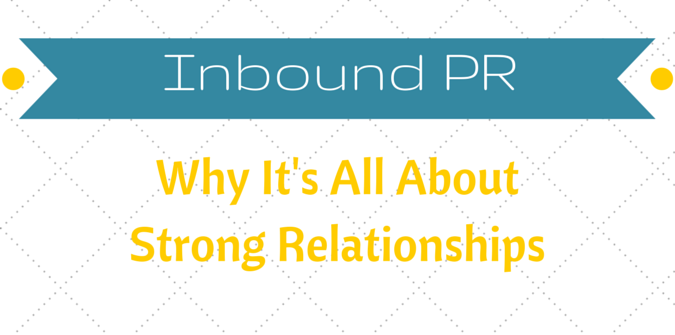Table of Contents
There are a lot of differences between “traditional” and “inbound” PR, but at the end of the day they’re both built on the same foundation: relationships. Throw any adjective you want in front of PR, but relationships will always be there.
First, let’s talk about inbound PR in general. What is it? In terms of tools, tactics, and even activities, think of your average “PR 2.0” shpiel. What sets inbound PR apart is the mindset. Instead of focusing on pitching and pushing out content like news releases, the focus is on building relationships. That way you have a network that’s coming to you with inquiries, and you can take your pick of which outlet to give the exclusive to.
“Inbound PR attempts to create as much of a relationship and value with media contacts up front (“what I can do for you”), reversing the traditional relationship of endlessly calling media contacts only when there’s a pitch to be delivered (“what you can do for me”).” – Shift Communications (source)
Inbound PR tactics like link building can work on their own, but not well enough. If you want this stuff to really change your world (or your brand), you need to do some networking. And I’m not talking about shaking hands at a meetup or passing out business cards at a conference.
If your want to bring your PR inbound, you need to build real connections.
In this post, we’re going to talk about:
- The inbound PR activities that benefit most from strong relationships
- How to start making connections
1. Link building
In the past, link building has only been reactive: you kept a spreadsheet of already published pages with link opportunities, reached out to the webmaster, and hoped they edited the content.
And yes, that works. But you don’t always need to wait for someone to publish a page to ask for a link. You can be proactive and look for future link opportunities when your spreadsheet starts to get a little empty, or work is slower.
You’re writing content that people want to link to. The problem here is, they can only link to it if they’re aware of it. Someone might be writing a post right now where a link to your website would be perfect, but he’s never heard of you.
People can’t link to content if they don’t know it exists. That’s why public relations is so important to all content marketing initiatives. When people need a resource to link to, or to find a stat or quote, they usually have a list of favorite publications they turn to first – you want to be on this list.
By building relationships with your company’s target audience and the publications they read, you’ll be able to better distribute and build links to content. For example, say you email a colleague a link to your latest blog post because you’ve talked with her about the topic before. Down the road, she’s assigned a post on a similar topic. She’ll hopefully remember your post and reference it in her own.
For example, at Mention we have a lot of great “industry friends.” And I’ll frequently be reading one of their posts and follow a link that actually takes me to Mention’s own blog. I didn’t ask them to put it there, and there’s no effort on Mention’s part other than maintaining our relationships.
Here’s an example from a blog post about relationship marketing, published by CoSchedule:
By building relationships and sending people content that will be helpful to them, you’re adding a proactive layer to your link building strategy.
Best practices:
- Try to avoid pitching a link to someone you don’t know. Sometimes it’ll be unavoidable, but some name recognition and rapport to go along with your pitch will always improve its chances of being picked up.
- Track your progress. Take a cue from old school link building and keep track of link opportunities – but from websites you have a relationship with. I’m probably biased, but I like BuzzStream for this.
- Link it forward. When you’re asking someone for a link, it helps if you’ve linked to them before. Never underestimate someone’s feelings of obligation (just kidding).
2. News coverage
Pitching reporters is still a great way to get more eyes on your latest press release. But the morning that your press release goes live should not be when you email a reporter for the first time.
Why? Your pitch has a much higher chance of being accepted if the reporter already knows you.
First of all, they’ll recognize your name among the dozens (or hundreds!) of emails in their inbox folder for all pitches. But since you also have spoken before, they likely already know a little about your company, making it easier to write about. Finally, a relationship will have built rapport and trust – so a tip coming from you means more than one coming from a stranger.
Take a look at the sample email below. If you were a journalist and received that email (and really had been excited when talking to the PR rep), wouldn’t you figure out a way to move that writing assignment to the top of your to-do list?
Best practices:
- Read your beat regularly. This way you know which reporters are covering it.
- Follow reporters. It makes it really easy to keep track of what they’re working on, and gives you the chance to engage with them on social.
- Add context to pitches. When you do pitch, show you did your research with a line like, “I saw you wrote about Company X’s similar update, so I thought you might be interested in…”
3. Building an earned audience
I mentioned it earlier, but I’ll go into more detail here: the content marketing team needs help from PR. Because content needs an audience, and PR pros are good at finding them.
Inbound PR should support inbound marketing in any way it can. In particular, the PR team should be involved in outreach to promote new pieces of content, as well as any social media campaigns.
For PR pros, relationships (especially with media) are your thing. So if your company has a new infographic it wants to send to a list of target publications, you’re the best person for that.
Why? After all, I’m sure the content’s author can write a pitch. But you’re the one with contacts at media outlets already. And like I said before, a reporter is more likely to accept a pitch from someone they know. It’s also easier for a publication than making them try to keep track of multiple people at one company.
Best practices:
- Stay close to the marketing team. In order to help them best, you all need to be working closely to make sure you’re all working towards the same goals.
- Organize it. Not all your contacts will be looking for content. Know what each person in your network wants and needs, in order to pitch them only the most relevant stuff.
- Plan ahead. While you’re working with marketing, build all outreach and PR into the initial strategy so marketing understands how you’ll be chipping in.
Conclusion
If you’re used to sending out cold pitches, this post might leave you feeling discouraged. “You mean I can’t pitch a reporter unless I know them? Getting to know them first will take so much longer, and we need coverage now.”
I get it. I do. But here’s the quick fix: build relationships before you need them. You know your company and its audience. Start researching outlets and contacts, reaching out, and adding them to your database now. You can set aside a block of time each week to check in with your contacts. That way, the next time you have something to pitch, the rapport is already there.
Just remember there’s a reason inbound PR is also called slow PR – so start early and check in often.




 Check out the BuzzStream Podcast
Check out the BuzzStream Podcast

